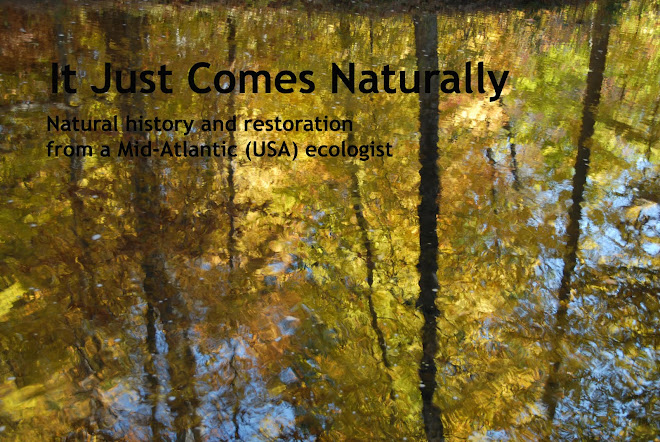We had a fine autumn weekend (for a change) here in the Mid-Atlantic--temperatures in the upper 50s and sunny skies both days. On Saturday, we went to an Orvis trunk show and I bought one pair of poplin slacks, two pairs of shorts and seven new shirts. Whoo-whoo! I cleaned up. Then we went for a six-mile walk along a river in a park in the western suburbs.
On Sunday morning, we went for a four-mile walk in the county park downstream of my usual natural area. This park has a new rail-to-trail path paralleling the same creek that flows through "my" natural area. The light of the late morning sun glinting on the creek from the path made the stream look like it was quicksilver.
Along the opposite side of the trail, a small tributary draining a beech and tuliptree forest poured over a tiny falls created by leaves caught in the roots of a streamside tree.
 Further downstream, we came across a runner enjoying the park's hilly terrain. I liked this image because there's a hint of mossy green to enliven the sere November landscape.
Further downstream, we came across a runner enjoying the park's hilly terrain. I liked this image because there's a hint of mossy green to enliven the sere November landscape.  At its southern end, the rail-to-trail path runs within a deep rock cut excavated into the schist bedrock of the valley. The locals call this cut "the gorge." I like it because the excavation intercepted the groundwater and produced a long series of weeping springs emerging from the uphill side (left side in the image) of the rock cut. Unfortunately, the rocks are covered with non-native vegetation--especially English ivy (Hedera helix) and Japanese honeysuckle (Lonicera japonica).
At its southern end, the rail-to-trail path runs within a deep rock cut excavated into the schist bedrock of the valley. The locals call this cut "the gorge." I like it because the excavation intercepted the groundwater and produced a long series of weeping springs emerging from the uphill side (left side in the image) of the rock cut. Unfortunately, the rocks are covered with non-native vegetation--especially English ivy (Hedera helix) and Japanese honeysuckle (Lonicera japonica).  Novertheless, clusters of ferns manage to cling to the stony walls in places. If the invasive vegetation weren't there, imagine what kinds of native gems might gain a footlold in this unusual niche.
Novertheless, clusters of ferns manage to cling to the stony walls in places. If the invasive vegetation weren't there, imagine what kinds of native gems might gain a footlold in this unusual niche.
















